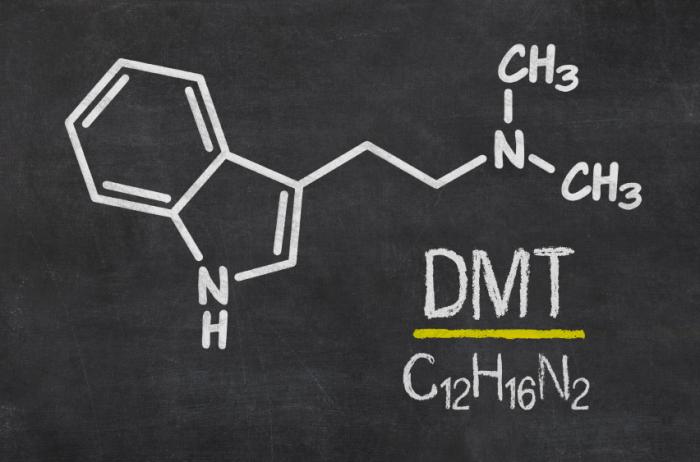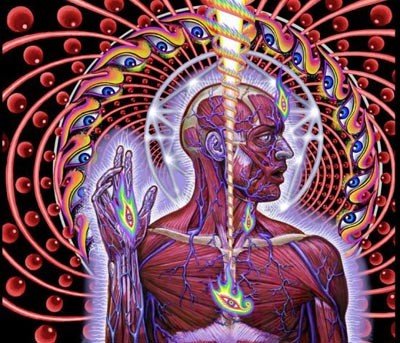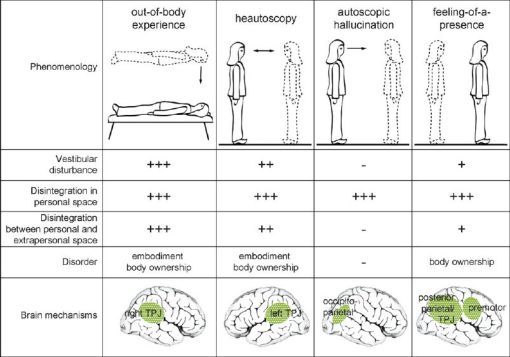DMT : "the molecule of spirit", involving near-death and out-of-body experiences
How DMT impacts consciousness through Near-death and Out-of-Body experiences ?
Consciousness have always been an important subject for several scientific realms as psychology and philosophy. It's actually starting to catch the attention of neuroscientifics as well, who are starting to focus on subjective experiences. Near Death Experience (NDE) can be an entry for the comprehension of consciousness especially as these experiences can occur under the influence of DMT (dymethyltryptamine), also called the spirit molecule by Rick Strassman. Mr. Strassman, a renowned researcher in the field, was the first one being interested in the effect of DMT on healthy people. It led to observe Near-death (NDE) and Out-of-Body (OBE) Experiences which are closely linked, showing how people's fear is attenuated after an NDE in the sense that they feel they are not alive anymore. OBE, which has been thought as paranormal was reported by a lot of people after brain seizures, severe stress episodes, and has mainly been aknowledged thanks to W. Penfield at 1940' using electric stimulation in an epileptic patient. In this way, it's remarkable to be aware how subjective experiences can impressively contribute to increase the knowledge about conscioussness.
What is DMT ?
Dimethyltryptamine or N-N-DMT is a simple compound found throughout nature and which has profound effects on human consciousness. This molecule is known for its psychedelics effects and recognized as an illegal drug in many countries. When we look at the chemical structure of the DMT, we can see that it has similar configuration with psilocin and serotonin. It's interesting to know that Psilocin is a hallucinogen found in mushrooms.

Credit to : www.medicalnewstoday.com
To know more about DMT...
Actually DMT is a derivative of Tryptophan, which is an amino-acid used in the biosynthesis of proteins. By the way, Tryptophan is a precursor to the neurotransmitter serotonin and the hormone melatonin. And both of them are synthesized by the pineal gland. So it can explain this similar chemical configurations between serotonin, psilocin and tryptophan. Moreover, the psychiatrist and researcher Rick Strassman, who is the first one to study the effects of injection psychedelic drug (DMT) on healthy human body, supposes that DMT is also released by the pineal gland.
To be clear : DMT is widely available in plants or animals all around the world. All organisms have tryptophan, and all organisms have the two key enzymes that lead to the synthesis of DMT. That’s why theorically, any organism could synthesize DMT. So this endogenous molecule can be released by the pineal gland, through meditation or under specific stress stimulation as well.
How researchers see this molecule ?
Leanna Stadish, ND, PhD – a Naturopathic Physician - thinks that DMT may be the common molecular language among all living beings on this planet. Mention may be made by what she said : « I can’t think to a more powerfull tool, to explore the question of what is consciousness ». In the same perspective, Rick Strassman who probably shares the same point of view, called DMT « the molecule of spirit ». He supposes big similarities between psychedelics and experiences possible with long meditation. These findings led Rick Strassman to think that an important release of endogene DMT must be correlated with mystical and Near Death Experiences (NDE).
And if we believe the Rabbi Joel Bakst, DMT could be the hormon which facilitates the entery and exity of soul in the body. At least it’s what the jewish sage mystics have described in a coded langage in litterature for thousand of years.
Physiological, psychological and cognitive effects
Concretely, DMT is a molecule which can be inhaled, injected or orally ingested. Its effects depend on the dose. When inhaled or injected, the effects last a short period of time : about 5 to 15 minutes. Effects can last 3 hours or more when orally ingested along with an MAOI, such as the ayahuasca.
In his study, Rick Strassman decided to inject it intravenously, to volunteer patients. When DMT is administered by this way, the answer is very rapid and has a very short duration action because it’s rapidly broken by the body.
Participants described intensive physiological, psychological and cognitive effects of the DMT, such as rapid heart rate, increased blood pressure, loss of muscle coordination, nausea, vomiting for the physiological ones.
Psychological effects are flashbacks, chronic auditive and visual hallucinations, mood disorder, anxiety... and the cognitive ones are colored geometrics shapes, feeling of beeing out-of the body like floating in the air, alltered time perception, accelerated time and thoughts, like in a cosmic dimension, sensation to be in a tunnel, perceiving a bright light.

Credit to : https://www.irishtimes.com/student-hub/everything-is-propaganda-1.2868609
Concept of death
As we all thought about at least once in our lifes, fear of death is one of the most profound of human anxieties. At some stage we all die. We may not know when or how, but we do know that death is certain for everyone. The conceptualisation of death in many Western societies is typically based on an objective mechanistic model of dying. According to this model, when our physiological structure ceases to function, we die, and that is the end. « Nothing survives … nothing lives on. » In this sense, « death is often defined and understood by many, as an exclusively physical process, in which annihilation of the self is the outcome. » The question of how we deal with death is highly correlated with our cultural and religious background, as every single thing concerning ourselves and from over there, our identity. We often talk about the fear of death but it turns out that death can be seen as a new beginning in some religions, which should be taken into consideration toward self-conception of time, the senses and internal psychological/spiritual aspects.
What about near-death experience
The near-death experience (NDE) and its associated pattern of after-effects present an absorbing exception to this norm. Although the common assumption, death anxiety is an intrinsic part of the human condition; those who meet with an NDE frequently appear to have transcended the fear of death. Here it might be wondered whether we can find same conclusions for people who think about afterlife. NDE can be defined as a « subjectively profound psychological experience, which deviates from currently accepted norms of reality, due to the transcendence of space, time and perceptual boundaries ».
An experience like NDE, which can occur during a time span as fleeting as a cardiac arrest for example, can cause such a significant and common psychological shift in people who experience them. Also inetresting to mention a current empirical article suggesting NDEs occur in around 5–20% of cardiac arrest survivors, and 4–9% of the general population.
« There is too much informations to process in a few minute span »
Reported emotional elements can include intense positive affect, such as joy, happiness, peace and unconditional love. Seeing and being drawn to an unusually bright light, encountering deceased others, communicating with a being of light and cosmic unity are among the transcendental elements. NDEs are generally perceived positively by the experiencer, with relatively few distressing experiences reported. However, unpleasant NDEs have been described.
Some typical cognitive elements as extraordinary conscious abilities, including an altered perception of time, enhanced awareness, instantaneous memory revival and the perceived separation of mind from body have been found as well, thanks to personal experiences. Some of these can include the termination of significant relationships, changes in employment and/or in life priorities and goals and initial declines to subjective well-being.
Positive psychological outcomes tend to result, and can include: greater concern or compassion for other people, enhanced appreciation and subjective quality of life, positive attitude towards self, enhanced sense of self-identity, reduced consumerism and materiality, reduced negative affect and cognitions, and a greater ‘thirst’ for knowledge. Ring (1984) claimed in his article that 80% of his NDE participants reported decreased or vanished fear of death. Furthermore, this loss of the fear of death appears to be maintained over time.
Can we be out of our bodies ?
Out-of-body experience (OBE) is a rare phenomenon during which one has the feeling of being located outside of the physical bounds of the body, along with the sensation of perceiving the world from an elevated perspective. OBE is of particular interest for studying self-consciousness, as it involves abnormal forms of self-location and visuo-spatial perspective, as Nakul & Lopez wrote. For a little focus on the brain, areas involved in OBE are the frontal and parietal lobes, limbic system, cerebellar and interoceptive processing regions with the temporoparietal junction. A lot of people can think that OBE is purely a product of the brain, as if the brain is constructing and imagining the body from different angles of view. The drawing below is trying to explain various autoscopic phenomenon and regions of the brain "affected" offering explanations, for people who are interested in it.

Taken from Blanke's book mentioned in bibliography
Here is a meaningful storytelling from a volonteer subject who experienced DMT « for a few minutes, you're immersed in sort of this raw data sphere of input of sensory memory inputs : it seems like the brain build reality out of these things : what you're experiencing, what you have experienced, and how you associate and syntesize these things together to tell yourself a story... especially about what's going on ».
Some articles were published, based on a qualitative way of analyse, which is interpretative phenomenological analysis (by Smith), and so reporting people's stories as they experienced them. Here are some extracts : « it was very scary, but I had actually given myself over it », « it absolutely changed me into bieng a sort of just living for, a normal life to seriously thinking about life », « it was a bit of a gift ».

Taken from : https://jefffinley.org/obe/
As a conclusion
The importance and contribution of subjective experiences have to be highlighted, expecially to understand this kind of « sensitive » experiences that we couldn't measure or see from a quantitative point of scientifical view. To have an NDE on purpose or not is a mean factor for sensation and effects arising therefrom in the sense that if it's from an external unintended cause such as accident, cardiac arrest, or electrucution for example, you won't be prepared psychologically to this significant experience. The transformative power of NDE and/or OBE are reshaping individual's existing concept of self, which can only be enlightened with a qualitative view to those personal experiences. Unfortunately, collapse of consciousness results from spiritual and scientific knowledge which split apart ; both of these modes of knowing have to come together for a holistic result. Strassman says that we can help to cure PTSD, drug and alcohol addictions, or anxiety with psychedelics, pushing scientifics and mainly people to break the barrier of pejorative vision concerning drugs seen as cure or medicine. Furthermore, researchers doing these experiments have to be sensible on cultural/religious beliefs when they try to interpret stories, because there is a considerable correlation between our beliefs/cultural values and what we experience in everyday life, as we already wrote.
I just wish to mention that I don't claim to be a scientist, so the text above is not a « scientific article » but much more an article review concerning DMT, NDE and OBE, made by research we did with a friend for an oral presentation.

Bibliograpy :
Blanke O., Landis T., Spinelli L. and Seeck M., (2004) Out-of-body experience and autoscopy of neurological origin, Brain , vol. 127, 243-258
Blanke O. and Arzy S., (2005) The Out-of-Body Experience: Disturbed Self-Processing at the Temporo-Parietal Junction, The Neuroscientist, vol. 11, no. 1, 16-24
Bos E.M., Spoor J.K.H., Smits M., Schouten J.W. and Vincent A.J.P.E. (2016) Out-of-Body Experience during Awake Craniotomy, World Neurosurgery, vol. 92, 586e9 – 586e13
Cheyne J.A., Girard T.A., (2009) The body unbound : vestibular motor hallucinations and out-of-body experiences, Cortex, vol. 45, 201-215
Greyson B. (2006) Near-Death Experiences and Spirituality, Zygon, vol. 41, no. 2, 393-414
Greyson B. (1983) The Near-Death Experience Scale : Construction, Reliability and Validity, The Journal of Nervous and Mental Disease, vol. 171, no. 6, 369-375
Le Maléfan P., (2011) The “Out-of-Body Experience” – A New Orientation for the Clinic of the Body, Recherches en psychanalyse, vol. 1, no. 11, 38a-46a
Nakul E. & Lopez C., (2017) Commentary: Out-of-Body Experience during Awake Craniotomy, Frontiers in Human Neuroscience, vol. 11, art. 417
Strassman R., (2000) DMT : The Spirit Molecule : A Doctor's Revolutionary Research into the Biology of NearDeath and Mystical Experiences, Park Street Press, 363p.
Tassel-Matamua N.A. & Lindsay N., (2016) “I’m not afraid to die”: the loss of the fear of death after a neardeath experience, Routledge, vol. 21, no. 1, 71–87
Wilkins L.K., Girard T.A., Cheyne J.A., (2011) Ketamine as a primary predictor of out-of-body experiences associated multiple substance use, Consciousness and Cognition, vol. 20, 943-950
Website sources :
Really interesting ;) Thank you for this review about DMT.
Thank you for your comment ! Happy if you liked it :)
I share your opinion, really great article
Thank you ! :)
You did a really good job, welcome back:)
Thank you !! :)
GReat Article ....This Organic chemistry really helped A lot in our lives ..i mean changed fully .....u nailed it simply and explained briefly ...i appreciate the way u defined it ....Thanks Alot For Sharing
Thank you for your comment :) Happy to know that it seems simple and brief!
I'm currently reading DMT: The Spirit Molecule. Thanks for sharing.
Enjoy your reading, it's such an interesting subject ! Thanks for your comment :)
Also, I think that image above is from Tool's Lateralus. Great, eye opening band. Cheers man.
What's the image you're talking about ? It'll be nice for me to know it 'cause it was a little difficult to be sure if the image sources were the right ones.
Bernard Werber, dans son livre L'Ultime Secret, émet l'hypothèse qu'à l'instant précis de la mort, la glande pinéale décharge une plus grande dose de diméthyltryptamine dans le cerveau, rendant le passage de vie à trépas moins pénible. Cette hypothèse expliquerait cette sensation de mort imminente relatée par certains utilisateurs de la DMT.
Exactement, je crois avoir parlé de cette hypothèse d'ailleurs, qui donne tout son sens à cette expérience de mort. D'ailleurs dans le reportage que j'ai mentionné en bibliographie, ils en parlent aussi. Savez-vous si l'hypothèse est sortie de Bernard Werber ou de quelqu'un d'autre ? Ce serait intéressant de le savoir pour le versant "culture".
Great article!
I´ve always been fascinated about DMT and the experiences it causes, now even more so!